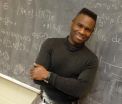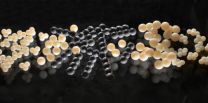(Press-News.org) CHAMPAIGN, Ill. — To engineers, it's a tale as old as time: Electrical current is carried through materials by flowing electrons. But physicists at the University of Illinois and the University of Pennsylvania found that for copper-containing superconductors, known as cuprates, electrons are not enough to carry the current.
"The story of electrical conduction in metals is told entirely in terms of electrons. The cuprates show that there is something completely new to be understood beyond what electrons are doing," said Philip Phillips, a professor of physics and of chemistry at the U. of I.
In physics, Luttinger's theorem states that the number of electrons in a material is the same as the number of electrons in all of its atoms added together. Electrons are the sub-atomic particles that carry the current in a conductive material. Much-studied conducting materials, such as metals and semiconductors, hold true to the theorem.
Phillips' group works on the theory behind high-temperature superconductors. In superconductors, current flows freely without resistance. Cuprate superconductors have puzzled physicists with their superconducting ability since their discovery in 1987.
The researchers developed a model outlining the breakdown of Luttinger's theorem that is applicable to cuprate superconductors, since the hypotheses that the theorem is built on are violated at certain energies in these materials. The group tested it and indeed found discrepancies between the measured charge and the number of mobile electrons in cuprate superconductors, defying Luttinger.
"This result is telling us that the physics cannot be described by electrons alone," Phillips said. "This means that the cuprates are even weirder than previously thought: Something other than electrons carries the current."
"Theorists have suspected that something like this was true but no one has been able to prove it," Phillips said. "Electrons are charged. Therefore, if an electron does not contribute to the charge count, then there is a lot of explaining to do."
Now the researchers are exploring possible candidates for current-carriers, particularly a novel kind of excitation called unparticles.
INFORMATION:
Phillips, U. of I. undergraduate student Kiaran Dave (now a graduate student at MIT) and University of Pennsylvania professor Charles Kane published their findings in the journal Physical Review Letters. The National Science Foundation and the Center for Emergent Superconductivity (through a DOE Energy Frontiers Research Center) supported this work.
Editor's note: To reach Philip Phillips, call 217-244-6703; email dimer@illinois.edu.
The paper, "Absence of Luttinger's Theorem due to Zeros in the Single-Particle Green Function," is available online.
Link to P. Phillips web page: http://physics.illinois.edu/people/profile.asp?dimer
Link to paper: http://prl.aps.org/abstract/PRL/v110/i9/e090403
Electrons are not enough: Cuprate superconductors defy convention
2013-03-19
ELSE PRESS RELEASES FROM THIS DATE:
Physicists use 3-D printing to test complex qualities of shapes made via computer
2013-03-19
Prof. Heinrich Jaeger's research group examines materials and phenomena that appear simple at the surface, but which reveal tremendous complexity upon close examination. One such phenomenon is jamming, in which aggregates of randomly placed particles, including spheres or more complicated shapes, or even molecules, transition from fluid-like to solid-like behavior.
Jamming lends itself to soft robotics, in addition to other applications as explored in a workshop at the University of Chicago last October. In recent computer simulations and experiments, Jaeger, the William ...
New nanomedicine resolves inflammation, promotes tissue healing
2013-03-19
NEW YORK, NY (March 18, 2013) —A multicenter team of researchers, including scientists at Columbia University Medical Center (CUMC), Brigham and Women's Hospital (BWH), Mount Sinai School of Medicine, and Massachusetts Institute of Technology, has developed biodegradable nanoparticles that are capable of delivering inflammation-resolving drugs to sites of tissue injury. The nanoparticles, which were successfully tested in mice, have potential for the treatment of a wide array of diseases characterized by excessive inflammation, such as atherosclerosis. The study was published ...
Sleep study reveals how the adolescent brain makes the transition to mature thinking
2013-03-19
(SACRAMENTO, Calif.) -- new study conducted by monitoring the brain waves of sleeping adolescents has found that remarkable changes occur in the brain as it prunes away neuronal connections and makes the major transition from childhood to adulthood.
"We've provided the first long-term, longitudinal description of developmental changes that take place in the brains of youngsters as they sleep," said Irwin Feinberg, professor emeritus of psychiatry and behavioral sciences and director of the UC Davis Sleep Laboratory. "Our outcome confirms that the brain goes through a ...
Toyota's management practices may improve the quality of hospital care
2013-03-19
PORTLAND, Ore. — Researchers have long surmised that management techniques successful in manufacturing and technology sectors may improve health care quality. However, there has been very little evidence about how these practices are disseminated in hospitals and whether they are associated with better performance.
A new study led by Oregon Health & Science University (OHSU) health economist K. John McConnell, Ph.D., reveals manufacturing management practices, including Toyota's "Lean" methodologies, may be beneficial in helping hospitals achieve "high-quality health ...
Gene profile may help identify risk for hormone-sensitive, hormone-insensitive breast cancer
2013-03-19
PHILADELPHIA — The overexpression or underexpression of a newly identified set of genes related to lipid metabolism may help physicians identify whether or not a woman is at risk for hormone receptor-positive or hormone receptor-negative breast cancer and to subsequently tailor prevention strategies appropriately, according to data published in Cancer Prevention Research, a journal of the American Association for Cancer Research.
"Currently, three drugs can be used to prevent breast cancer in women who are at extremely high risk for the disease," said Seema A. Khan, ...
Combined hyperbaric O2 -- normobaric hyperoxia associated with improved outcome of severe TBI
2013-03-19
Charlottesville, VA (March 19, 2013). Researchers at the Hennepin County Medical Center, University of Minnesota, and Minneapolis Medical Research Foundation (Minneapolis, Minnesota) report that the combined use of hyperbaric oxygen and normobaric hyperoxia therapies provides better outcomes in patients with severe traumatic brain injury (TBI) than the standard intensive neurosurgical care recommended for this injury. Full details on the effects of this combined treatment are provided in the paper "A prospective, randomized Phase II clinical trial to evaluate the effect ...
Genes identify breast cancer risk and may aid prevention
2013-03-19
CHICAGO --- A newly identified set of genes may predict which women are at high risk for getting breast cancer that is sensitive to estrogen and, therefore, would be helped by taking drugs to prevent it, reports a new Northwestern Medicine study.
"We now have the possibility of predicting if a preventive drug will work for a woman at high risk of breast cancer, so that we don't expose women to the risks and side effects of this drug if it won't help them," said Seema Khan, M.D., senior author of the study, which will be published March 19, 2013 in the journal Cancer ...
Military personnel return to duty following severe injury to lower extremity
2013-03-19
CHICAGO – High-energy lower-extremity trauma (HELET) is common in modern warfare, often resulting in severe tissue damage, chronic pain, neurovascular injury and significant muscle loss, according to the new research presented today at the 2013 Annual Meeting of the American Academy of Orthopaedic Surgeons (AAOS).
The Return to Run (RTR) program is an integrated orthotic and rehabilitation initiative designed to return high-level function to wounded warriors. It includes use of the new Intrepid Dynamic Exoskeletal Orthosis (IDEO), a custom-fit device made from carbon ...
Depression in Alzheimer's patients associated with declining ability to handle daily activities
2013-03-19
New York, NY (March 18, 2013)—More symptoms of depression and lower cognitive status are independently associated with a more rapid decline in the ability to handle tasks of everyday living, according to a study by Columbia University Medical Center researchers in this month's Journal of Alzheimer's Disease.
Although these findings are observational, they could suggest that providing mental health treatment for people with Alzheimer's disease might slow the loss of independence, said senior author Yaakov Stern, PhD, professor of neuropsychology (in neurology, psychiatry, ...
Origins of human teamwork found in chimpanzees
2013-03-19
Teamwork has been fundamental in humanity's greatest achievements but scientists have found that working together has its evolutionary roots in our nearest primate relatives – chimpanzees.
A series of trials by scientists found that chimpanzees not only coordinate actions with each other but also understand the need to help a partner perform their role to achieve a common goal.
Pairs of chimpanzees were given tools to get grapes out of a box. They had to work together with a tool each to get the food out. Scientists found that the chimpanzees would solve the problem ...

